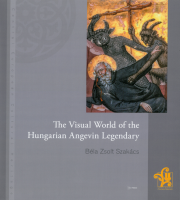The first volume of the Central European Cultural Heritage Series
Dispersed in two continents, four countries and six collections; many of its pages were cropped, cut into four, or lost forever; its history, origin, commissioner and audience are obscure; still, in its fragmented state it presents fifty-eight legends in abundant series of images, on folios fully covered by miniatures, richly gilded, using only one side of the fine parchment; a luxurious codex worthy of a ruler; a unique iconographic treasury of medieval legends; one of the most significant manuscripts of the medieval Hungarian Kingdom – these are all what we call the Hungarian Angevin Legendary.
The largest part of what remained of the codex was bound together in the eighteenth century in a volume housed in the Vatican Library. Some of the missing pages, often incomplete, have resurfaced in different parts of the world only to disappear again, finding their way into collections from the United States to Russia. Their common origin has only been discovered in the course of modern research. Those, who were privileged enough in the fourteenth century to page this codex, were probably interested in the identity of the saints they revered, their lives, and their accomplishments. For today’s observers, however, the primary role of the surviving codex pages is rather to illuminate the way people in the fourteenth century viewed them. This book seeks to answer these emerging questions through a study of the visual program of the Hungarian Angevin Legendary.
Review in Journal of Ecclesiastical History:
"This book is a tour de force in analysing the artistic and historical questions surrounding the manuscript. Szakács discusses previous scholarship, providing a survey of the literature, as well as pointing out the limitations of research. Based on the codicological analysis of the surviving folios, he reviews what we can know about the lost material. He then considers the choice of the particular saints and the episodes that are represented. Recurring visual elements are scrutinised. Finally, the context, the creation of the codex is examined. This volume is a major contribution not simply to medieval Central European art history and history, but also to the study of hagiography and medieval image cycles more generally."
More information about the book and how to order it:
http://ceupress.com/book/visual-world-hungarian-angevin-legendary
